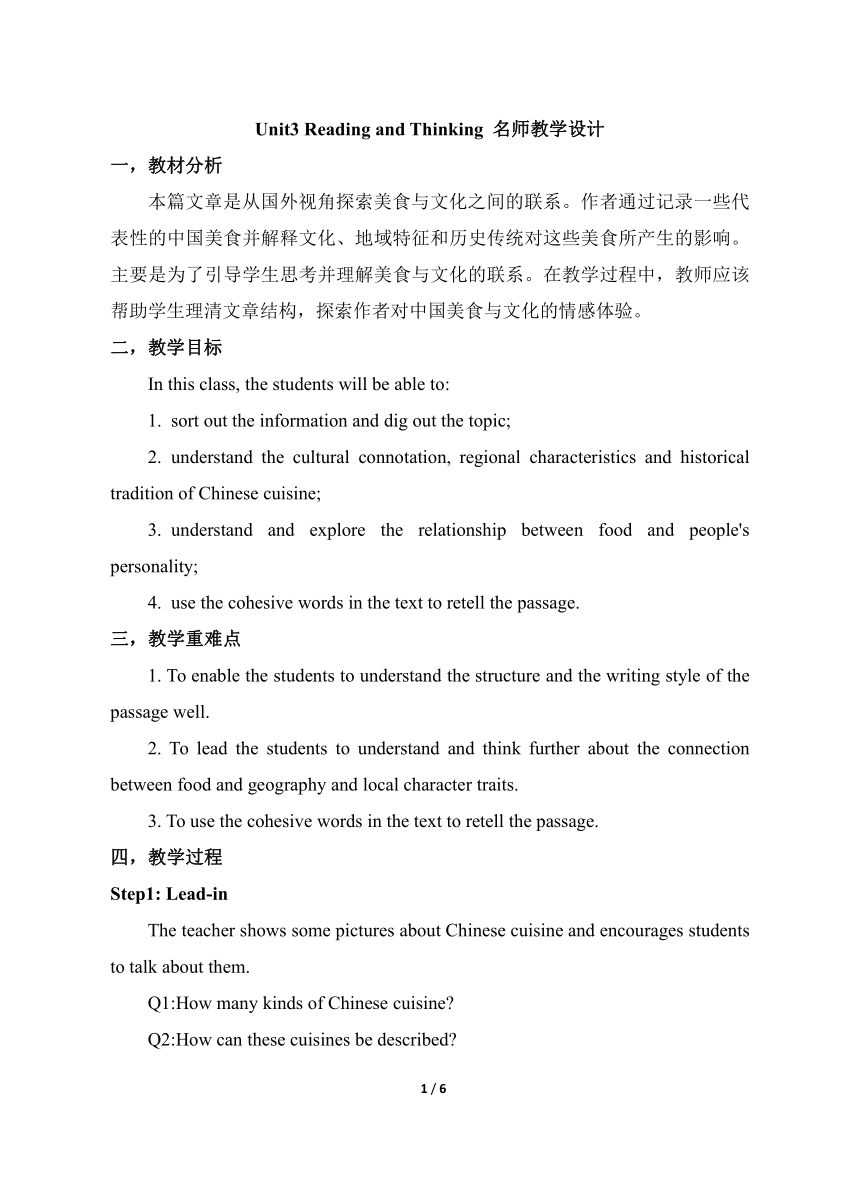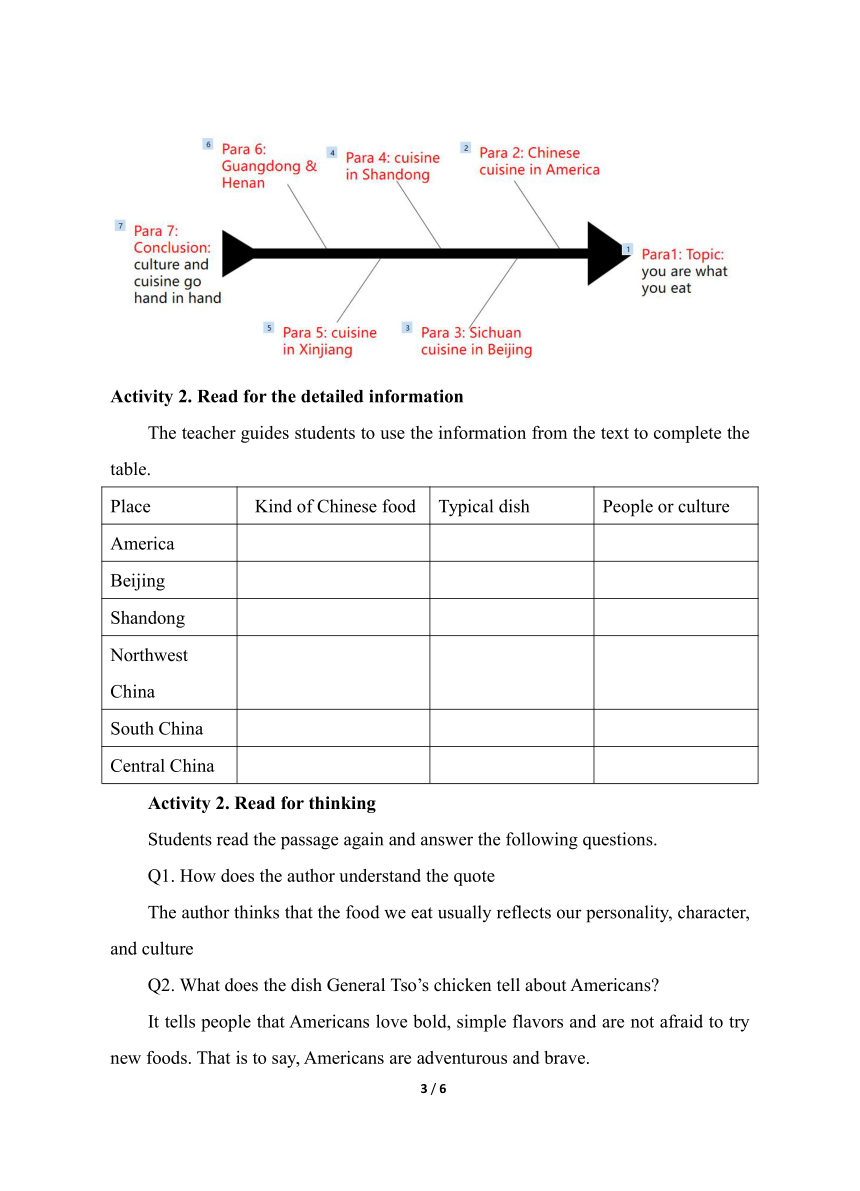人教版(2019)选择性必修第二册 Unit3 Food and Culture Reading and Thinking 名师教学设计
文档属性
| 名称 | 人教版(2019)选择性必修第二册 Unit3 Food and Culture Reading and Thinking 名师教学设计 |  | |
| 格式 | doc | ||
| 文件大小 | 486.5KB | ||
| 资源类型 | 教案 | ||
| 版本资源 | 人教版(2019) | ||
| 科目 | 英语 | ||
| 更新时间 | 2023-03-12 15:12:53 | ||
图片预览



文档简介
Unit3 Reading and Thinking 名师教学设计
一,教材分析
本篇文章是从国外视角探索美食与文化之间的联系。作者通过记录一些代表性的中国美食并解释文化、地域特征和历史传统对这些美食所产生的影响。主要是为了引导学生思考并理解美食与文化的联系。在教学过程中,教师应该帮助学生理清文章结构,探索作者对中国美食与文化的情感体验。
2,教学目标
In this class, the students will be able to:
1. sort out the information and dig out the topic;
2. understand the cultural connotation, regional characteristics and historical tradition of Chinese cuisine;
3. understand and explore the relationship between food and people's personality;
4. use the cohesive words in the text to retell the passage.
三,教学重难点
1. To enable the students to understand the structure and the writing style of the passage well.
2. To lead the students to understand and think further about the connection between food and geography and local character traits.
3. To use the cohesive words in the text to retell the passage.
四,教学过程
Step1: Lead-in
The teacher shows some pictures about Chinese cuisine and encourages students to talk about them.
Q1:How many kinds of Chinese cuisine
Q2:How can these cuisines be described
Q3:What, if anything, do these cuisines tell you about the people who eat them
( Aims: to motivate the students’ related knowledge and elicit the topic for the preparation of the following reading.)
Step2: Prediction
Before reading, students will be asked to focus on the title and the picture of the passage. Then, they need to make predictions about this passage.
Q1: What content will this passage talk about
Q2: Which information would you like to get
keys: It is about various culture and cuisine about a place or some countries.
( Aims: to train students’ ability to predict the content by concentrating on the title and some pictures; to activate the interest in the following reading.)
Step3: While-reading
Activity 1. Read for the main idea and structure
The students skim the passage quickly, match the main idea of each paragraph and draw the structure of the text.
Activity 2. Read for the detailed information
The teacher guides students to use the information from the text to complete the table.
Place Kind of Chinese food Typical dish People or culture
America
Beijing
Shandong
Northwest China
South China
Central China
Activity 2. Read for thinking
Students read the passage again and answer the following questions.
Q1. How does the author understand the quote
The author thinks that the food we eat usually reflects our personality, character, and culture
Q2. What does the dish General Tso’s chicken tell about Americans
It tells people that Americans love bold, simple flavors and are not afraid to try new foods. That is to say, Americans are adventurous and brave.
Q3.What impressed the writer most while in Beijing
The friendship offered by people.
Q4. How do you like the characters of people in Beijing from the author’s experience
They are friendly and amicable (友善的).
Q5. What is important to people in Shandong according to the writer
According to the writer, family is important to people in Shandong.
Q6. What do you know about the personality of people in North China
People in North China attach importance to their family, so they are a family-centered person.
Q7. Why did people in northwest China enjoy cooking over an open fire
Because they traditionally wandered the open range on horses.
Q8. What do we know about people in northern Xinjiang according to their food
They are bold, rash and frank
Q9.What does elegant dim sum mean
Small servings of food in bamboo steamers.
Q10. What is the personality of people in south China
People in south China are careful and considerate.
Q11. What does the food local people consume tell the writer
It tells us what people grow in their region and what kinds of lives they lead, what they like or dislike.
Activity 4. Summary
Trace the author’s travels again and understand the quote “you are what you eat”.
Activity 5. Understand causes and effects
Learning tips are shown. Then, the teacher leads the students to understand causes and effects from each paragraph. The students match the causes to the effects.
Cause
1.The flavor preferences of Americans often differ from those of the Chinese
2.We had no idea how to order food.
3.These groups traditionally wandered the open range on horses.
Effect
A:The chef just began filling our table with the best food we had ever eaten.
B:Their traditional foods are what you can cook over an open fire.
C: Chinese food in America is changed to suit American tastes.
keys:1. C 2. A 3.B
Learning tip
Understand cause and effectSometimes two ideas are related to each other by cause and effect. That is, one thing causes something else to happen. Cause-and-effect relationships can be direct. For example, “ It was raining, so I took my umbrella. However, some cause-and-effect relationships are not direct, and some may also have more than one cause or effect.Tips: How to identify cause and effectLook for signal words, such as therefore/ as a result/ because/ so/ due to...Find them through a logical connection.
( Aims: to train students’ summary skills and enable them to understand the structure of this passage well by faster reading; to guide them understand the language features of the text.)
Step 4: Deeper thinking
Q1: Do you think “Culture and cuisine go hand in hand Give your reasons.
Keys: Personally, culture and cuisine go hand in hand. Reasons are as follows: Cuisine in certain place can tell us what the local people like to eat, grow or dislike. The food flavors they eat the food features they cook also well demonstrate the personality, characters or culture of the local people.
( Aims: to boost the critical thinking of students through discussion .)
Step 5: Homework
1. Write a summary about one of the author’s experiences based on the table.
2. Try to describe a food that impressed you.
2 / 2
一,教材分析
本篇文章是从国外视角探索美食与文化之间的联系。作者通过记录一些代表性的中国美食并解释文化、地域特征和历史传统对这些美食所产生的影响。主要是为了引导学生思考并理解美食与文化的联系。在教学过程中,教师应该帮助学生理清文章结构,探索作者对中国美食与文化的情感体验。
2,教学目标
In this class, the students will be able to:
1. sort out the information and dig out the topic;
2. understand the cultural connotation, regional characteristics and historical tradition of Chinese cuisine;
3. understand and explore the relationship between food and people's personality;
4. use the cohesive words in the text to retell the passage.
三,教学重难点
1. To enable the students to understand the structure and the writing style of the passage well.
2. To lead the students to understand and think further about the connection between food and geography and local character traits.
3. To use the cohesive words in the text to retell the passage.
四,教学过程
Step1: Lead-in
The teacher shows some pictures about Chinese cuisine and encourages students to talk about them.
Q1:How many kinds of Chinese cuisine
Q2:How can these cuisines be described
Q3:What, if anything, do these cuisines tell you about the people who eat them
( Aims: to motivate the students’ related knowledge and elicit the topic for the preparation of the following reading.)
Step2: Prediction
Before reading, students will be asked to focus on the title and the picture of the passage. Then, they need to make predictions about this passage.
Q1: What content will this passage talk about
Q2: Which information would you like to get
keys: It is about various culture and cuisine about a place or some countries.
( Aims: to train students’ ability to predict the content by concentrating on the title and some pictures; to activate the interest in the following reading.)
Step3: While-reading
Activity 1. Read for the main idea and structure
The students skim the passage quickly, match the main idea of each paragraph and draw the structure of the text.
Activity 2. Read for the detailed information
The teacher guides students to use the information from the text to complete the table.
Place Kind of Chinese food Typical dish People or culture
America
Beijing
Shandong
Northwest China
South China
Central China
Activity 2. Read for thinking
Students read the passage again and answer the following questions.
Q1. How does the author understand the quote
The author thinks that the food we eat usually reflects our personality, character, and culture
Q2. What does the dish General Tso’s chicken tell about Americans
It tells people that Americans love bold, simple flavors and are not afraid to try new foods. That is to say, Americans are adventurous and brave.
Q3.What impressed the writer most while in Beijing
The friendship offered by people.
Q4. How do you like the characters of people in Beijing from the author’s experience
They are friendly and amicable (友善的).
Q5. What is important to people in Shandong according to the writer
According to the writer, family is important to people in Shandong.
Q6. What do you know about the personality of people in North China
People in North China attach importance to their family, so they are a family-centered person.
Q7. Why did people in northwest China enjoy cooking over an open fire
Because they traditionally wandered the open range on horses.
Q8. What do we know about people in northern Xinjiang according to their food
They are bold, rash and frank
Q9.What does elegant dim sum mean
Small servings of food in bamboo steamers.
Q10. What is the personality of people in south China
People in south China are careful and considerate.
Q11. What does the food local people consume tell the writer
It tells us what people grow in their region and what kinds of lives they lead, what they like or dislike.
Activity 4. Summary
Trace the author’s travels again and understand the quote “you are what you eat”.
Activity 5. Understand causes and effects
Learning tips are shown. Then, the teacher leads the students to understand causes and effects from each paragraph. The students match the causes to the effects.
Cause
1.The flavor preferences of Americans often differ from those of the Chinese
2.We had no idea how to order food.
3.These groups traditionally wandered the open range on horses.
Effect
A:The chef just began filling our table with the best food we had ever eaten.
B:Their traditional foods are what you can cook over an open fire.
C: Chinese food in America is changed to suit American tastes.
keys:1. C 2. A 3.B
Learning tip
Understand cause and effectSometimes two ideas are related to each other by cause and effect. That is, one thing causes something else to happen. Cause-and-effect relationships can be direct. For example, “ It was raining, so I took my umbrella. However, some cause-and-effect relationships are not direct, and some may also have more than one cause or effect.Tips: How to identify cause and effectLook for signal words, such as therefore/ as a result/ because/ so/ due to...Find them through a logical connection.
( Aims: to train students’ summary skills and enable them to understand the structure of this passage well by faster reading; to guide them understand the language features of the text.)
Step 4: Deeper thinking
Q1: Do you think “Culture and cuisine go hand in hand Give your reasons.
Keys: Personally, culture and cuisine go hand in hand. Reasons are as follows: Cuisine in certain place can tell us what the local people like to eat, grow or dislike. The food flavors they eat the food features they cook also well demonstrate the personality, characters or culture of the local people.
( Aims: to boost the critical thinking of students through discussion .)
Step 5: Homework
1. Write a summary about one of the author’s experiences based on the table.
2. Try to describe a food that impressed you.
2 / 2
